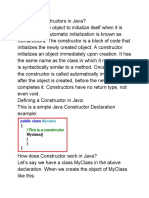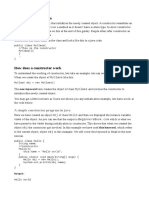0% found this document useful (0 votes)
12 views14 pagesJava Constructors
Java constructors are special blocks of code used for object creation and initialization, having the same name as the class and no return type. There are three types of constructors: default, parameterized, and copy constructors, each serving different initialization needs. Constructor overloading allows multiple constructors in a class with different parameter lists, enhancing flexibility in object instantiation.
Uploaded by
Pooja NCopyright
© © All Rights Reserved
We take content rights seriously. If you suspect this is your content, claim it here.
Available Formats
Download as PDF, TXT or read online on Scribd
0% found this document useful (0 votes)
12 views14 pagesJava Constructors
Java constructors are special blocks of code used for object creation and initialization, having the same name as the class and no return type. There are three types of constructors: default, parameterized, and copy constructors, each serving different initialization needs. Constructor overloading allows multiple constructors in a class with different parameter lists, enhancing flexibility in object instantiation.
Uploaded by
Pooja NCopyright
© © All Rights Reserved
We take content rights seriously. If you suspect this is your content, claim it here.
Available Formats
Download as PDF, TXT or read online on Scribd
/ 14




























































































